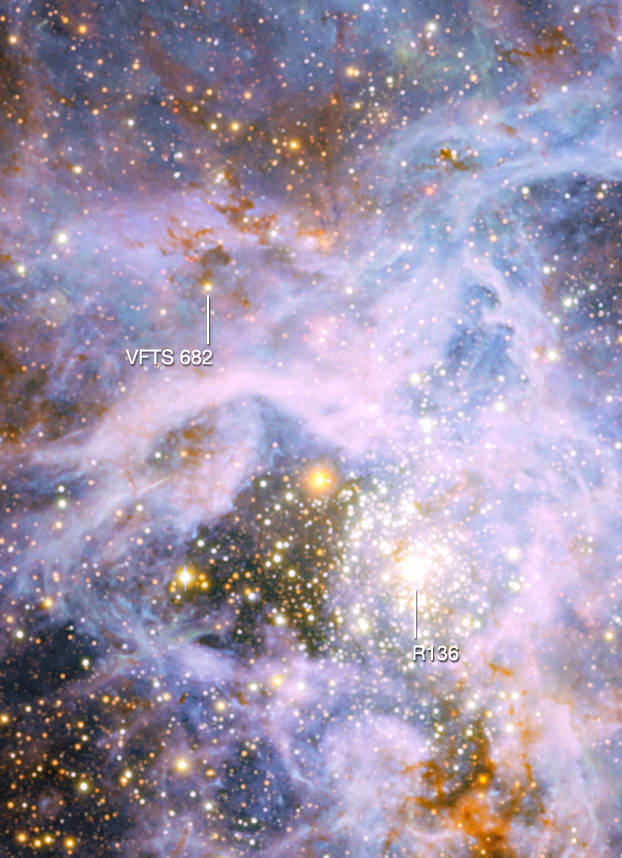[/caption]
It hangs out in space some 160,000 light years away. Its neighborhood is the Large Magellanic Cloud. It calls the Tarantula Nebula home. It’s 150 times more massive than our Sun and it shines an astounding three million times brighter. What is it? Try a lone super star…
Utilizing the power of ESO’s Very Large Telescope, a team of international astronomers have been checking out star VFTS 682 in the Large Magellanic Cloud. Using an instrument aptly named FLAMES, they also discovered the star to be very hot, with a surface temperature of about 50 000 degrees Celsius. While most of the initial findings were rather unremarkable, when researchers cleared away the dust clouds they discovered this super star stood alone.
“We were very surprised to find such a massive star on its own, and not in a rich star cluster,” notes Joachim Bestenlehner, the lead author of the new study and a student at Armagh Observatory in Northern Ireland. “Its origin is mysterious.”
Why an enigma? For the most part, stars like VFTS 682 are found in the crowded centers of galactic clusters. They are young, hot and bright – destined to live short and explosive lifetimes. Their high mass makes them a candidate for an even more dramatic end – a long-duration gamma-ray burst, the brightest explosion in the Universe. It could happen to other super stars in the nearby stellar nursery cluster, because it has a sibling.
“The new results show that VFTS 682 is a near identical twin of one of the brightest superstars at the heart of the R 136 star cluster,” adds Paco Najarro, another member of the team from CAB (INTA-CSIC, Spain).
So how did VFTS 682 end up being solitary sun? There is speculation that it could be a “runaway”… ejected from its nest. But such a scenario is unlikely since it is doubtful such a heavy star could be thrown from the cluster by gravitational interactions.
“It seems to be easier to form the biggest and brightest stars in rich star clusters,” adds Jorick Vink, another member of the team. “And although it may be possible, it is harder to understand how these brilliant beacons could form on their own. This makes VFTS 682 a really fascinating object.”
Shine on, you crazy diamond!


Excellent idea – VFTS 682 shall forever be named Sid. After all, that is who the song is about.
Couldn’t it be as simple as (1) just enough mass in a given cloud of gas/dust that is much denser then surrounding area, and (2) 3 or 4 stellar explosions in even spaced around the gas cloud, where the shockwave hits at approximately the same time? It might be uncommon, but it still is possible.
I think you need only one supernova near a cloud to trigger star formation though.
On a similar note, I don’t get why a massive star is unlikely to be flung out of a cluster with some similar massed stars around.
Yes, you only need one shockwave to start the action. however it would push gas in an arc, and most likely trigger a few stars, not just one. This is the point of asking how such a single star could be created. 2 shockwaves in opposite directions would push in a bar. 3 shockwaves would push to a point. This is my basis for saying it would be created from a 3 or more shockwaves converging in a single area at a similar time.
As for gravitation interaction, with only one other star nearby of a similar size the stars could only orbit each other and have the smaller stars orbit them. This is the equivalent of a big guy/small guy fight. The small guy can’t budge the big guy much, but it’s very easy for the big guy to push the small guy.
When you have a small/large situation, the smaller object will orbit around or fall towards the large object. When you have 2 stars of the same mass, their gradational effect cancels out, causing them to orbit mutually or fall together mutually. A good little tool I found is http://www.nowykurier.com/toys/gravity/gravity.html. It’s very useful for visualizing gravity interactions.